Food for thought
- Ideas vs Big Ideas
- Advertising Ideas vs Ideas Worth Advertising
- There’s a Social Recipe for creating shareable ideas
Every campaign should have a BIG idea at its center. But what’s the difference between an idea and a BIG Idea?
A BIG Idea isn’t a tactic, or a one-off. It’s not just one video, one IG post, or one poster. A Big Idea has a concept at its core that you can base an entire campaign on; that can go on and on and on in multiple types of media; and that consumers and the press want to share.
A BIG Idea doesn’t just promote; it attracts. We live in a world where social media dominates. We get our news from social media. We learn the latest trends from social media. And we connect with brands via social media.
Chances are, your future clients don’t want to spend tens of millions of dollars to launch a product or service by paying for traditional media like TV, radio and print. They prefer to use social media to attract their customers with magnetic ideas and hope their customers will want to spread the word for them – at little or no cost.
BIG Idea Example 1
Here’s an example of a campaign by a major fast-food chain that attracted so much attention and participation that it set the standard for future campaigns in the fast food category:
Burger King considers itself a “challenger brand” and uses its underdog status to take on McDonald’s – the market leader. In 2015, BK leveraged a unique insight: people want to be able to enjoy a Whopper wherever they are. To bring this insight to life, BK’s ad agency, FCB New York, decided to revise BK’s app to allow customers to pre-order a Whopper for just one cent – not at Burger King – but when they were within 600 feet of any McDonald’s in the United States. The result: Burger King expanded its footprint, increased its sales, and downloads of its app.
In a bold move, Burger King customers who wanted to unlock the one cent whopper had to be within 600 feet of a McDonald’s. Only then could they download the digital coupon from the BK app. BK used this ingenious geo-targeted campaign idea to attract fast-food lovers and generate HUGE word of mouth – all while spending a minimum amount of marketing dollars.
The campaign was called “The Whopper Detour”. Here’s how it worked.
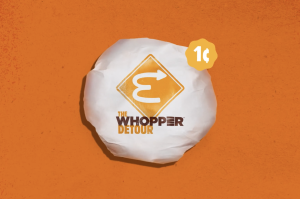


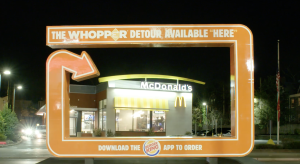

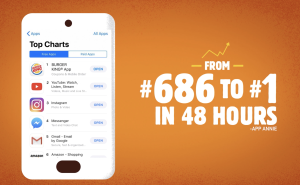

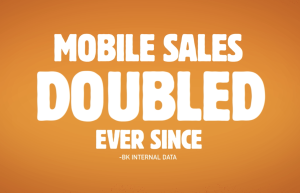
The Whopper Detour campaign generated more than 5 billion impressions, a ton of PR, and won every award under the sun.
Watch the full video case study here: https://vimeo.com/321155848
What was Burger King’s Big Idea? Get customers to take a Whopper detour and earn a one-cent Whopper.
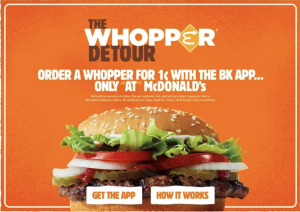
BIG Idea Example 2
Here’s another example of a Big Idea. This campaign was created by REI, the outdoor company.
REI was founded as a co-op in 1938 by Lloyd and Mary Anderson, a climbing enthusiast couple. Their goal: make outdoor gear available and affordable.
As REI planned for the upcoming holiday season in 2015, the company held an internal meeting to discuss its operations and marketing. At that meeting the CFO asked a surprising question: should we stay open on Black Friday or give employees Black Friday off?
The insight at play here was that it’s REI’s to help people get outdoors. Yet on Thanksgiving, instead of enjoying nature together, families rushed into stores of every kind in order to save a buck. This crass consumerism didn’t fit with REI’s brand values.
That’s how #OptOutside was born. The idea started small – with the company shutting its stores – IRL and online – so that REI employees would have the day off to be outdoors with their families. And it grew from there. Soon REI was inviting its customers to join them outdoors on Thanksgiving instead of rushing stores for door buster deals.
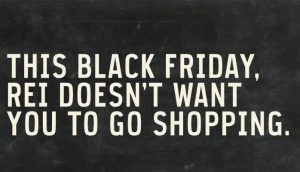
But it didn’t stop there. #OptOutside grew into a movement. REI partnered with non-profits like the National Parks Service and expanded #OptOutside to more than 700 partner organizations. The initial purpose of the campaign was to take a stand against consumerism in favor of spending time in nature. But over the next few years, REI challenged even more brands to take a stand – against consumerism and in support of environmental causes. So that there would still be an outside to opt in for.
Over time, the reach and impact of the #OptOutside movement became clear. By 2019, as the global threat of climate change dominated news headlines and contributed to an already charged political environment in America, REI repositioned #OptOutside. Initially a call for individuals to connect with nature instead of consumerism, the 2019 campaign sought to extend both the purpose and the timeframe of the movement. Sub-branded as “Opt to Act: 52 weeks of action to leave the world better than we found it,” the latest incarnation of #OptOutside finds REI recommitting to reducing its own environmental impact. The brand has pledged that it will be a zero-waste company (meaning that 90% of waste is diverted from landfills) by the end of 2020 by expanding its gear trade-in and rental programs and eliminating poly packaging for shipped orders.
Learn more about the campaign’s evolution and impact in this Sprout Social case study: https://sproutsocial.com/insights/social-spotlight-rei/.
REIs ad agency, Venables & Bell, put together this 2-minute case study video that shows the campaign creative and the impact #OptOutside had. Go ahead and watch. I’ll wait.

BIG Idea Example 3
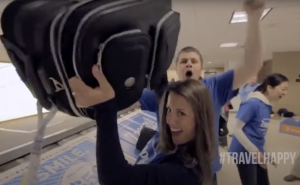
- Do something for your customer
- Make sure your idea allows customers to participate and find a way to invite them to join in
- Document their participation so the campaign lives on through content they (and the brand) create
- Make it shareable across the relevant media platforms
Social Recipe Example
Each year on Labor Day, a holiday meant to honor America’s workers, brands launch LABOR DAY SALE campaigns, offering discounts and sales.
Red Wing Shoe Company took a different approach. The company, a family-owned business founded in 1905 is known for making durable, quality work boots for people who work in the trades. Recently, their footwear has gone lifestyle; worn by those who value work boots crafted with pride and purpose, who embrace Red Wing’s motto: “Out of Fashion since 1905”.
On Labor Day of 2020, Red Wing, the company that has made boots for the workers who built America knew the U.S. was facing a record high unemployment rate. No doubt the Covid pandemic played a part. Instead of running yet another Labor Day Sale campaign, the shoe maker decided together with its ad agency, Droga5, to turn a holiday that had become synonymous with discounts back into a day for the American worker. Instead of promoting their workboots, Red Wing promoted every available job the company had with the launch of our #LaborDayOn campaign.
Here’s how it worked.
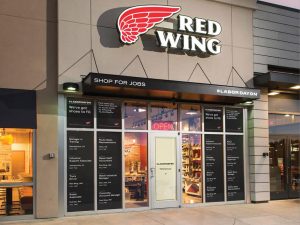
Red Wing converted its 525 brick and mortar stores into job centers. Red Wing’s 1-800 customer-service line became a job-search hotline. The company also launched an interactive film that allowed people to apply for actual Red Wing job openings directly through the film itself.
Then Red Wing went one step further: it took out a full-page ad in the New York Times to ask other brands to post any open jobs they had with #LaborDayOn.

The result: a global response, with over 200 brands joining #LaborDayON —including Burger King, Vice, Refinery29, New Balance, Chobani, UPS, Gap, Old Navy, Trek, Athleta, Audible, ADT, Mattress Firm and United Rentals, to name a few.
The campaign could be considered a success if just one person found a job. With 826 million media impressions, the campaign was far reaching, and the impact wasn’t just felt by unemployed Americans; some participating brands reported upwards of a 600 percent increase in applications for open jobs they were in desperate need of filling.
Learn more about the campaign in this case study from Droga5.
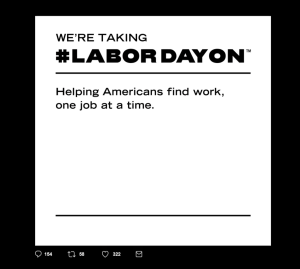
- Do something for your customer: Provide job openings to help unemployed Americans find work on Labor Day
- Make sure your idea allows customers to participate and find a way to invite them to join in: Convert Red Wing stores into job centers; convert Customer Service into a job search hotline; invite other brands to post their openings; post job openings on Red Wing’s website and on Instagram, Facebook, and Twitter
- Document their participation so the campaign lives on through content they (and the brand) create; Post job openings from Red Wing and other brands on Social Media; Posts on Social Media showing what workers did on their day off
- Make it shareable across the relevant media platforms; use the hashtag #LaborDayOn; Social Media platforms Instagram, Twitter, Facebook
- Instead of saying something, can we do something for your customer
- Instead of controlling the content, how can we invite customers to co-create the content
- Instead of a message-based interruption, how can we document the participation and creation of the content
- Instead of relying exclusively on paid media, how can we share the story via owned and earned media; what hashtag should we use; which media platforms make the most sense
Key Takeaways
Next up: How to come up with ideas – tricking your mind using the Creative Process
